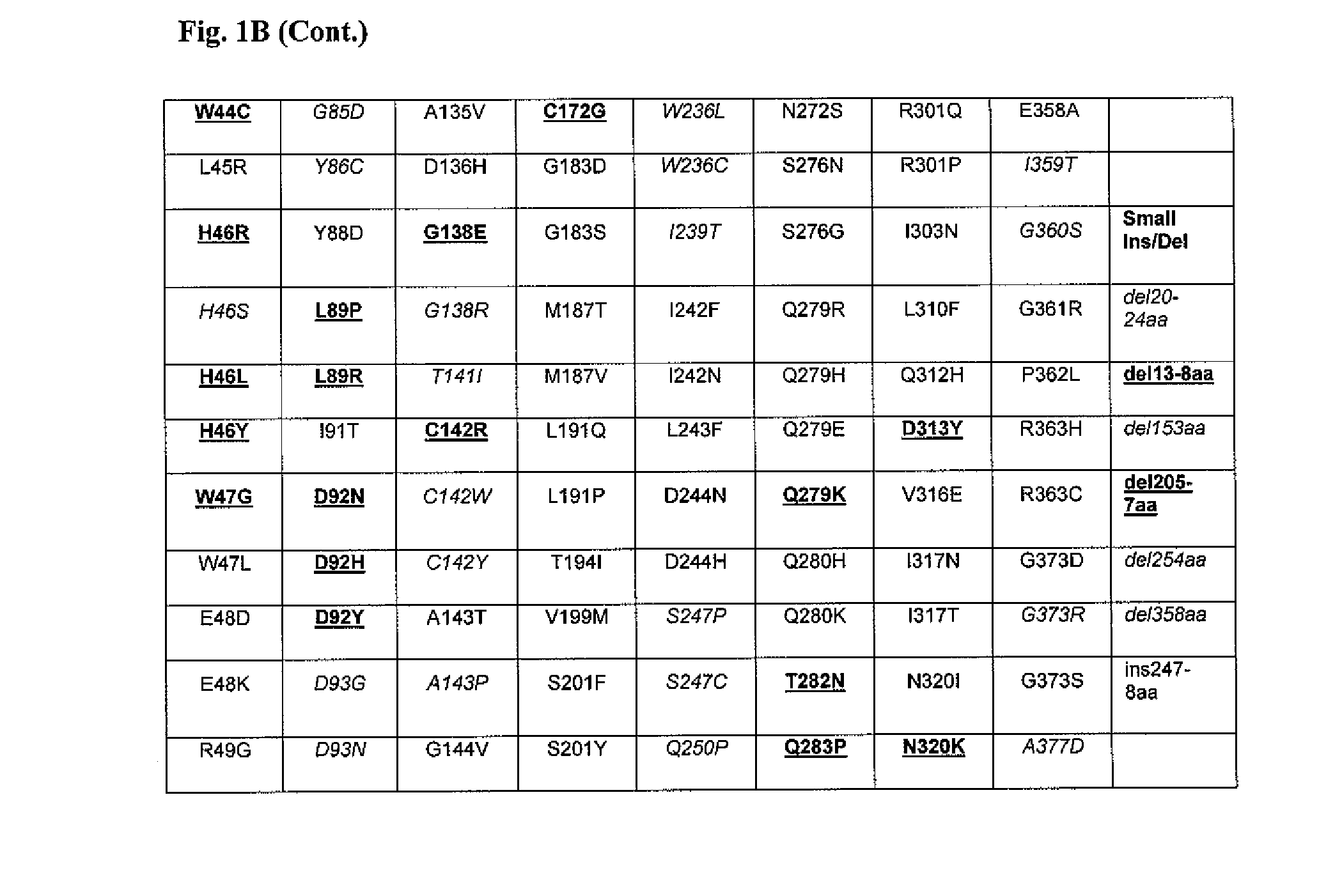Method to predict response to pharmacological chaperone treatment of diseases
a technology of pharmacological chaperone and disease, applied in the field of method to predict the response to pharmacological chaperone treatment of diseases, can solve the problems of protein stability reduction, protein level of biological activity reduction, and prevent protein folding properly, so as to increase the activity of protein, and evaluate protein activity
- Summary
- Abstract
- Description
- Claims
- Application Information
AI Technical Summary
Benefits of technology
Problems solved by technology
Method used
Image
Examples
example 1
Identification of Fabry Disease-Causing Mutations That Are Responsive to the Pharmacological Chaperone DGJ
[0134]The present Example provides the in vitro diagnostic assay to determine a Fabry patient's responsiveness to a specific pharmacological chaperone.
Introduction
[0135]Fabry disease is a lysosomal storage disorder caused by mutations in the gene that encodes α-galactosidase A (α-GAL A). Over 600 Fabry mutations have been reported, and about 60% are missense. The iminosugar DGJ is currently being studied in Phase 2 clinical trials as a pharmacological chaperone for the treatment of Fabry disease. Previously, it has been shown that DGJ mediates selective and dose-dependent increases in α-Gal A levels in many Fabry patient-derived lymphoid cell lines. To identify additional DGJ-responsive mutations, GripTite 293 MSR, (Invitrogen Corp., Carlsbad, Calif., U.S.A.) cells were transiently transfected with expression vectors containing all known α-Gal A missense mutations and several in...
example 2
Ex vivo Method for Evaluating Effects of an SPC on Glucocerebrosidase Activity—Prophetic Example
[0148]Gaucher disease (GD) is caused by a deficiency of lysosomal glucocerebrosidase (GCase). Deficient GCase activity leads to an accumulation of glucosylceramide (GlcCer) and the development of symptoms such as anemia, thrombocytopenia, hepatosplenomegaly, bone necrosis, infarcts and osteoporosis, and in some cases, neuropathic disease. The specific pharmacological chaperone isofagomine tartrate (IFG) selectively binds and stabilizes mutant (N370S / N370S) GCase in the ER and increases its trafficking to the lysosome.
[0149]To evaluate the effects of IFG on different GCase variants, an ex vivo diagnostic assay will be prepared using Cos7 cells in order to ascertain IFG-responsive mutations.
[0150]Using the techniques described in Examples 1 and 4, COS-7 cell lines will be prepared that express missense mutations and several in-frame small deletions and insertions by site-directed mutagenesi...
example 3
In vivo Effect of an SPC on α-GAL A Activity in Skin, Heart, Kidney and Plasma
[0153]To determine if increased mutant α-Gal A levels translate to increased α-Gal A activity in situ, the effect of DGJ administration on tissue GL-3 levels was investigated in vivo in hR301Q α-Gal A Tg / KO mice.
[0154]Eight-week old male hR301Q α-Gal A Tg / KO mice were treated for 4 weeks with 300 mg / kg DGJ in drinking water either daily or less frequently (4 days ON / 3 days OFF). After dosing, lysates were prepared from skin, heart, kidney, and plasma by homogenizing ˜50 mg tissue in Lysis Buffer (see above). 20 μL lysate were mixed with 50 μL of substrate (as detailed above). Reaction mixtures were incubated at 37° C. for 1 hr. After, 70 Stop Solution were added and fluorescence was read on a Victor plate reader as described above. Enzyme activity in the lysates was background subtracted, and normalized for protein concentration. A 4-MU standard curve was run for conversion of fluorescence data to absolute...
PUM
| Property | Measurement | Unit |
|---|---|---|
| pH | aaaaa | aaaaa |
| emission wavelengths | aaaaa | aaaaa |
| emission wavelengths | aaaaa | aaaaa |
Abstract
Description
Claims
Application Information
 Login to View More
Login to View More - R&D
- Intellectual Property
- Life Sciences
- Materials
- Tech Scout
- Unparalleled Data Quality
- Higher Quality Content
- 60% Fewer Hallucinations
Browse by: Latest US Patents, China's latest patents, Technical Efficacy Thesaurus, Application Domain, Technology Topic, Popular Technical Reports.
© 2025 PatSnap. All rights reserved.Legal|Privacy policy|Modern Slavery Act Transparency Statement|Sitemap|About US| Contact US: help@patsnap.com



